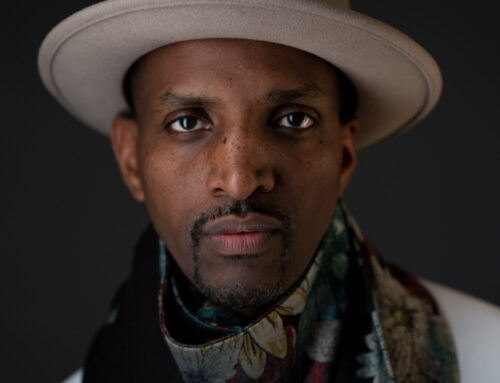By Prizgar Gonzales
They came from everywhere, the rich, the famous, the not so rich, and not so famous. Celebrity after celebrity greeted him as he sat on the floor close to the door, hands folded, with a look reminiscent of a little boy waiting for his parents he knew would never show up. The event was Jean-Michel Basquiat’s 21st birthday party, and unlike most of the great masters whose works received the world’s adulation long after their death, this young artist basked in his glory.
The lavish bash hosted by Andy Warhol, Basquiat’smentor, and confidant, brought out New York and Hollywood’scrème de la crème celebrity crowd to honor the artist. Explosive sounds of champagne corks, in sync with the DJ’s erotic baseline, eased New York’s nocturnals into their naturally debauched groove. Suddenly, cries for the birthday boy rang out. A search throughout the crowd revealed that he was nowhere to be found.
The celebration near combustion, Basquiat, trapped in a world all his own, had quietly slipped away and disappeared into the night. The streets of the New York night, his sanctuary, where his spirit found comfort. His vast studio, every wall a canvas.
His disappearance from the party was no surprise to this writer. As a resident woven into the fabric of Greenwich Village in the Eighties, during my nocturnal strolls, I had observed Basquiat perpetuating his artistic signature, Samo, on the walls of the Village.
As I attempt to capture his thoughts, in this rarest of moments, I imagined that while nestled in the comfort of his stretch limousine, he looked out at his imaginary footsteps on the sidewalks, tracing his symbol, his trap, his mystique that graffitiized the walls of the city. Around every corner, Samo, his mascot and his signature, now legendary, stared and watched over him. Known for his indulgences, he probably savored the moment by dipping into his black silk Armani suit, retrieving his toot. His money and notoriety, a magnet for the best hallucinogens in Alphabet City, located in the East Village a humming marketplace for the certified and exotic.
In many ways, New York City in the Eighties was an exercise in anarchy, especially for the nocturnal and creative. The confines of the limousine a haven for indulgence, a modern day chariot transforming dreams and fleeting moments. The artist used the night. The rapture is all their own.
As the limousine cruised along Avenue A, Basquiat reflected on his rapid rise to the top of the New York art world. Observing Tompkins Square Park, he ordered the limo driver to stop. Entering the park, he sprinkled a few dollars on the homeless multitude asleep. He spent many a night in the same position as these motionless ghosts.
Basquiat, however, had been a ghost on a mission. His homeless nights a meditative vigil, dreaming of tracking, hypnotizing and charming Andy Warhol, America’s art icon.The majordomo with the power to open doors or keep them closed. Nothing else mattered. Warhol was his ticket to fame and fortune.
In the solitude of the wee hours, as the Metropolis buzzed, Basquiat, cozied on the park’s bench, plotting. Up above, the Full Moon glistened. His artistic prowess, as if powered by cosmic octane, electrified his being. This was his moment, his canvas. He substituted the Moon’s face with Warhol’s. At ease, affirming the Law of Affirmation, he merged his soul with Warhol’s soul. He cherished the moment. His personal masterpiece. His spiritual bond unbeknownst to Warhol, signed and sealed. As the first ray of the sun’s rise heralds the new day, Basquiat arose, self-assured of his fame.
Other than the sleeping ghosts, Basquiat was alone in the park. At that moment, a mischievous smile displayed his assurance that the art world’s hierarchy was now burdened to adjust their marquee to include the name Jean-Michel Basquiat.
Standing over the present occupant of his bench, the still frame shielded by a blanket, Basquiat wondered about this person’s thoughts…his level of ambitions, the scope of his dreams. This same bench was his former meditative abode, that offered a fleeting escape from the metropolitan rat-race.
Reaching into his suit jacket, Basquiat retrieved his gold money clip, brimming with the spendable fruits of his creativity. He gently lifted the blanket and parted with the clip.
Basquiat’s studio was a revolving door where stardust and paint mixed and mingled. Awed, the chosen few, privileged to witness the young icon decode the spheres, extracting creativity from the Universe.
Today, Jean-Michel’s enlightened moments are worth mega millions. The wealthy that can afford his art is an exclusive and private club. The great museums of the world, jockey, and deal, awaiting their turn to pack in the crowds.
Jean-Michel Basquiat was a spirit in a hurry to make his statement on Planet Earth and move on. While he was still a toddler, his mother, Mathelde, as if realizing his destiny, walked with him through the corridors of the Brooklyn Museum and kept him fully supplied with the books and tools necessary for a burgeoning artist.
He left his parent’s home in Brooklyn at age seventeen, secure in his determination to take on the art establishment. With lightening-speed, Basquiat hurdled the art echelons that are now honoring him on par with Picasso, Matisse, and Van Gogh.
He came, he dared and he conquered. Everything he needed was a telephone call away, except the love from his distant Haitian father and his Puerto Rican mother, who after a nervous break-down was confined to an insane asylum.
The madness of living on the edge during the Eighties is no different from any other decade
when excessive drugs and art collide. However, in the Eighties, in Greenwich Village, New York City, artists enjoyed an unparalleled degree of freedom garnished with love-induced anarchy. Some like Madonna, whom Basquiat dated, also emerged from the Eighties, deftly side-stepped the madness and continue their creative journey.
It is difficult for an artist to pull back from the“Toot Boulevard” when the artist needs to be on that road for inspiration. Instead, Basquiat opted for the free fall when he overdosed at age 27, leaving behind brilliant and breathtaking art for the world to ponder. A body of work that is a haunting and stinging indictment of the Western World.





Leave A Comment